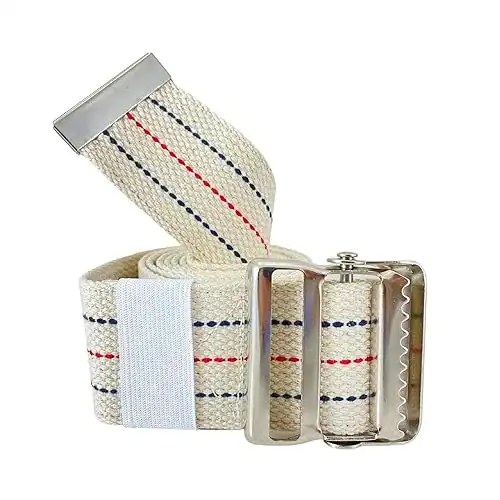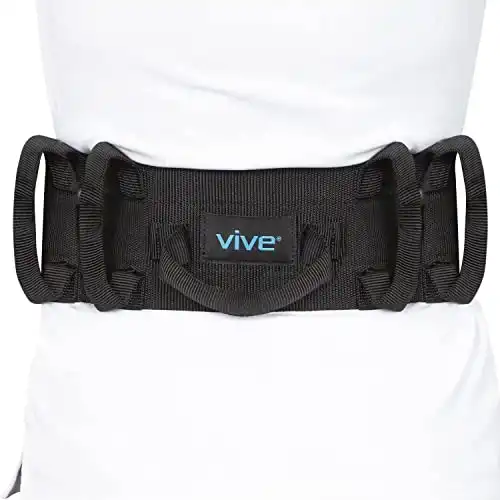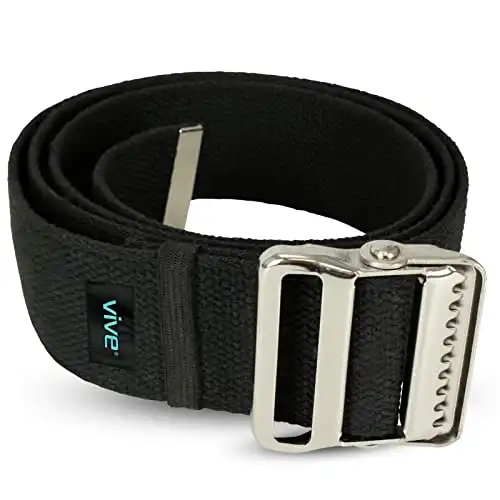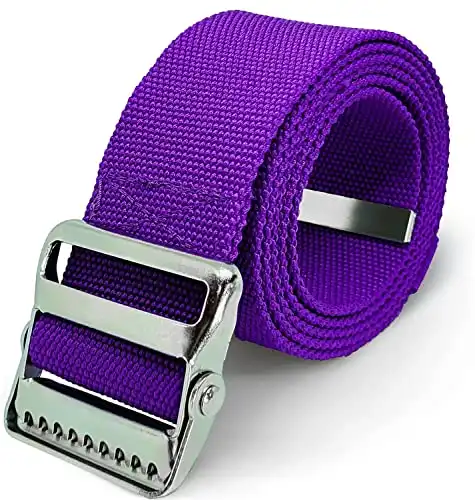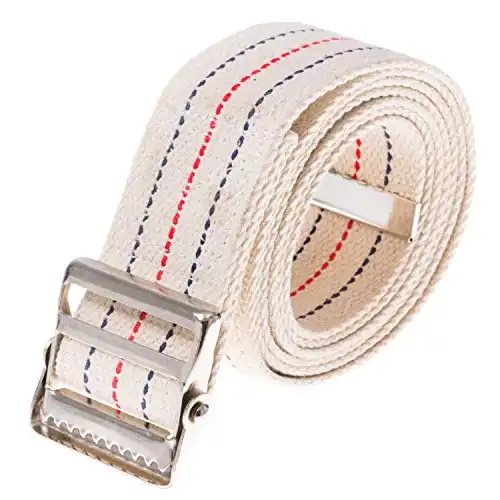A gait belt helps a caregiver easily and safely move a patient with reduced mobility. We have reviewed the best gait belts for elderly for you. If you are in a hurry, the table below provides a quick snapshot. Or you can scroll down for detailed reviews.
|
$6.97
|
$16.99
|
$9.99
|
$8.99
|
$8.99
|
Contents
What Is a Gait Belt?
A gait belt is used to help in moving a patient who can move a little but it is difficult for them to move due to old age, injury, pain in the joints, or other conditions. It is important to note that gait belts are only to be used if the patient can bear some bit of weight and move around at least for a few steps. Gait belts are only meant to assist the patient in getting up, sitting down or moving about.
A gait belt is secured around a patient, much like a normal belt. The patient is then lifted up by manually pulling them towards the caregiver. Proper body mechanics are extremely important when using a gait belt. The caregiver is also at risk of injuring his or her back while lifting the weight of the patient if proper posture is not maintained.
What Are Gait Belts Used For?
- Transferring: The patient can be lifted from a supine position to a sitting one, or from a sitting one to a standing one using a gait belt. When used this way, Gait Belts are also referred to as Transfer belts.
- Walking: Gait belts are also used to provide the patient support and helping them balance while moving in an assisted walk.
You may also like Best Sliding Transfer Benches With Swivel Seat
Where Should I Put My Gait Belt?
A gait belt should be put around the patient’s waist just like a normal belt. Once the belt is in place, the buckle in the front can be fastened, leaving just enough space for the caregivers’ fingers to be inserted in the belt, so that they can lift the patient.
Here we have a Youtube video on how to use gait belts properly.
How Do You Transfer a Patient With a Transfer/Gait Belt?
- Put the belt around the patient, fasten it leaving room only for your fingers
- Encourage the patient to push down if possible, while you lean towards them and grab the belt with both hands. Make sure that the patient is held at the waist, not the arms or shoulders
- Transfer the patient with your arms and legs, instead of your back muscles
- Make sure not to twist your body in transferring the patient
- When done, remove the gait belt.
How Do You Walk a Patient With a Gait Belt?
- Stand behind the patient, and to their side
- Place your hands in the belt, palm facing out with a firm hold
- Escort the patient, supporting them as they walk, avoid dragging them.
- Caregivers should guide the patient and provide support in lowering them safely to the ground in case they start to fall, using the belt to guide them downward with their spine gliding down the front of the caregiver’s leg.
You may also like Best Posterior Walker or Gait Trainer
Are Gait Belts Safe, and When Should You Not Use a Gait Belt?
A gait belt should only be used if the patient can bear at least some weight and is able to at least walk a few steps. A gait belt should only be used as an assistive device, not a lifting device, where the entire pressure of lifting the patient comes onto the caregiver.
Patients recovering from surgery or any condition that is related to the lower back should be cautious while using a gait belt.
Patients who have feeding tubes or catheters attached to them should use gait belts carefully so as to not obstruct them.
Patients with a wide girth or those with dementia or old war injuries should also avoid gait belts. People with cardiac problems, colostomy/ileostomy surgery, or respiratory issues, abdominal aneurysms should take special precautions when using gait belts.
When sliding a patient from a level surface, gait belts should be used along with a transfer board.
Gait Belt Alternatives
Gait belts are part of a universal set of transfer garments and devices which also include transfer vests, slings, and transfer discs.
Transfer vests are normal vests that have built-in handles that can be used to lift the patient up. Since the vest can be worn like a normal garment throughout the day, transfer vests are useful when the patient needs instant access to lifting support.
Transfer slings look like an open pair of shorts and are usually more robust or padded than gait belts. They provide additional support for the lumbar area and the lower trunk and they have handles for caregivers to support the patient as their position is changed.
What to Look For in a Gait Belt?
- Multiple handles: Multiple handles, in both horizontal and vertical, allow the caregiver to lift the patient efficiently and build a good grip.
- Quick-release/spring-loaded buckle: A quick-release or spring-loaded buckle makes opening and closing the belt easier.
- Anti-microbial coating: Anti-microbial coating on the inside of the belt helps to keep the belt clean and makes it easy to wash.
- Multiple sizes and bariatric options are good to have, so as to fit the patient comfortably.
You may also like Stand Assist Devices
Best Gait Belts for Elderly
In this section, we have reviewed the best gait belts for elderly to help you decide which options works the best for you.
Secure SGBM-60S Patient Transfer and Walking Gait Belt
The Secure SGBM-60S is your basic and most loved gait belt product out there. It features a 60-inch by 2-inch, beige, cotton webbing belt, with a high tensile metal buckle for interlocking safely and opening and closing conveniently.

The belt has a handy loop for locking the excess belt length, making it suitable for all sizes. There are optional handles available (can be bought separately on Amazon).
The belt is machine wash friendly and should be dried at high temperature (to remove infections). It offers a weight carrying capacity of up to 350 pounds.
The belt also has a 1 full year replacement warranty
Pros
- Basic gait belt with optional handles as per need
- Weight capacity of up to 350 pounds, length of up to 60 inches.
- Easy to wash in the machine, comfortable cotton webbing
Cons
- Some users have complained that the belt slips off and does not hold in place
- 60 inches can be a bit too long if the patient is very thin
Transfer vests
The Vive transfer belt is built from comfortable nylon webbing, which has been put together with strong, reinforced stitching. It fits well for people from waist sizes 28 to 50 inches and is wider than other belts(4 inches).

This belt offers 6 built-in handles – 4 vertical and 2 horizontal so that the patient can be comfortably lifted from any angle.
It also has a quick release, adjustable and durable buckle which can be used by the caregiver to easily do and undo the belt as per need.
The product is machine washable and comes with a 1-year long hassle-free replacement guarantee.
Pros
- Quick-release, strong and durable buckle
- Wider nylon webbing based belt
- 6 handles for ease of lifting the patient
Cons
- The belt buckle is plastic and does tend to break sometimes
- Belt slips when the patient is pear-shaped.
Vive Gait Belt (60 Inch)
This is the second Vive product to make this list! This 60-inch belt features a wide cotton webbing and no fuss easy release buckle for people with broader girth than usual.

The quick-release buckle has interlocking teeth which ensure that the belt does not slip when put under stress.
The belt supports weights of up to 500 pounds and features a 60-day guarantee for customers.
Pros
- Sturdy, strong buckle with interlocking metal teeth to avoid slipping
- Supports weights of up to 500 pounds, a waist size of 60 inches
- Machine wash and hand wash friendly
Cons
- Some customers have complained that the belt tends to unravel along its length, with threads separating from the belt.
LiftAid Walking Gait Belt
The LifAid walking gait belt sports a 60 inch by 2-inch frame, made of high-strength, high -durability material to withstand daily use.

It has an elastic loop for holding excess belt length over the high tensile strength metal buckle which provides for secure closure.
The belt has a carrying capacity of 300 pounds and is high-temperature machine washable. It also features a 1 years, fully covered warranty.
One striking feature of the LifAid walking belt is that it is available in several beautiful colours, unlike other gait belts. You can have a choice of Black/burgundy/Purple/Pink/Light Pink/Navy blue colours.
Pros
- Available in multiple colours
- Elastic loop for holding extra length of the belt
- Strong 60-inch high durable material.
Cons
- Buckle could be a bit easier to engage
COW&COW Gait Belt 60 inch
Cow & Cow Gait belt is the last in our list of gait belt options, but certainly not the least. This is the only belt to have options ranging from 54 to 60 to 72 to 100 inches in width (which means it supports people who need extra girth)

The product is made of super-strong cotton webbing and is available in a beige colour. It features a nickel-chrome plated steel buckle which is durable and secure and is easy to clasp and unclasp/
The 60-inch belt has a maximum weight carrying capacity of 350 pounds, but the higher length versions can support more. The product is easily washable in machine and can be hung up to drip dry. It is covered by a 1-year warranty
Pros
- Only belt with 72 and 100-inch length options
- Nickel-chrome plated durable steel buckle
- Weight capacity of 350 pounds
Cons
- The belt tends to unravel on continued long use

